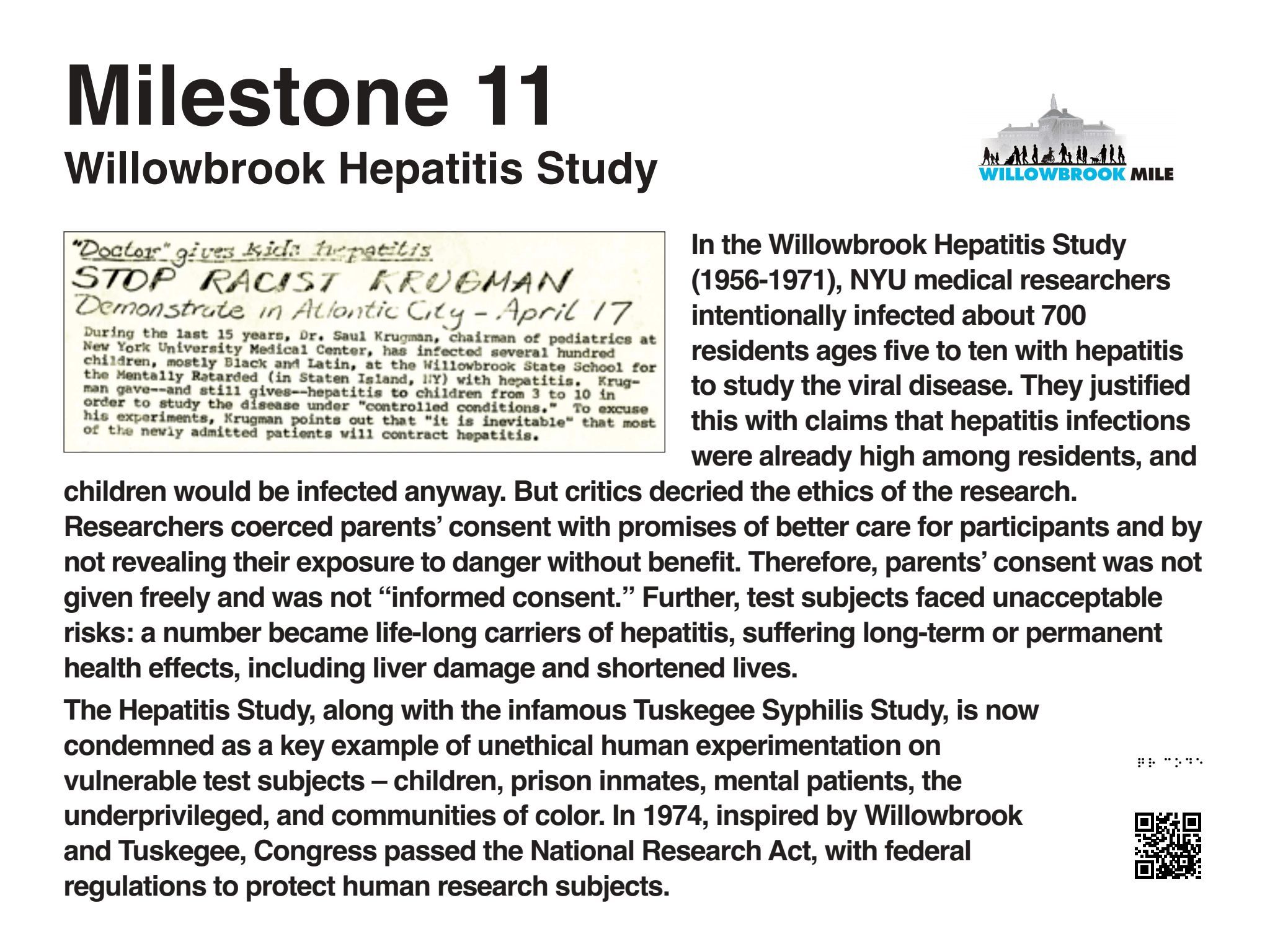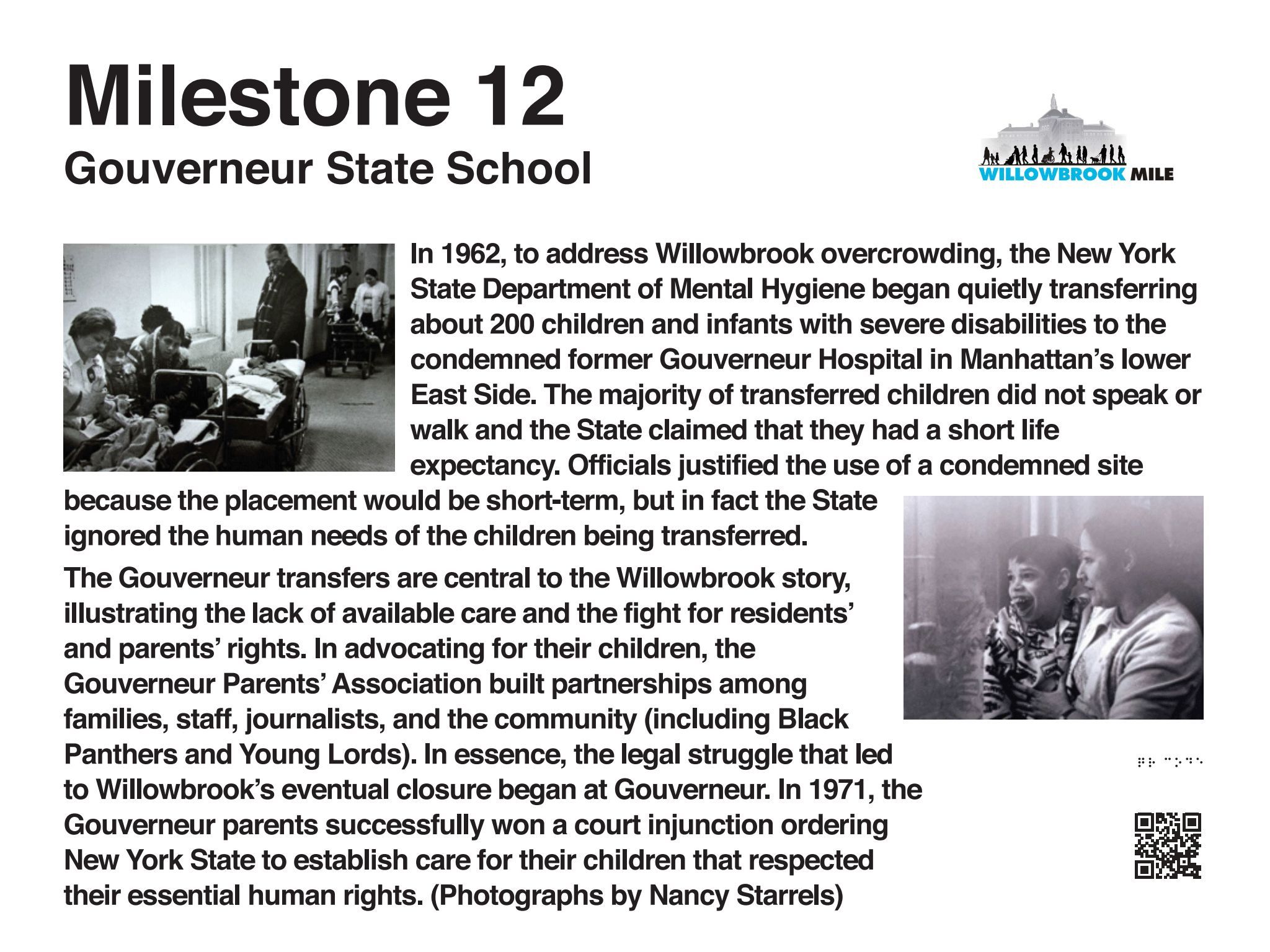
Milestone 01 - Willowbrook Archives
The College of Staten Island's Archives and Special Collections, located on the second floor of the College's Library (1L), opened in 2000. The research collection acquires and preserves materials documenting the history of the Willowbrook site prior to and during its use as a state school. Collections focus on the experiences of the school residents and staff, and the activities of parents and caregivers who brought about the closing of the school.
These collections provide a powerful first-hand narrative of the social justice fight carried on by residents, their families, and their allies that led to the closure of Willowbrook and for the rights of people with disabilities. Additional published materials analyze the legal significance of the Willowbrook Consent Judgement and its role in the history of the disability rights movement. The archives can be accessed by appointment. A representative selection of materials is online; a small exhibition can also be viewed off the Library Rotunda.
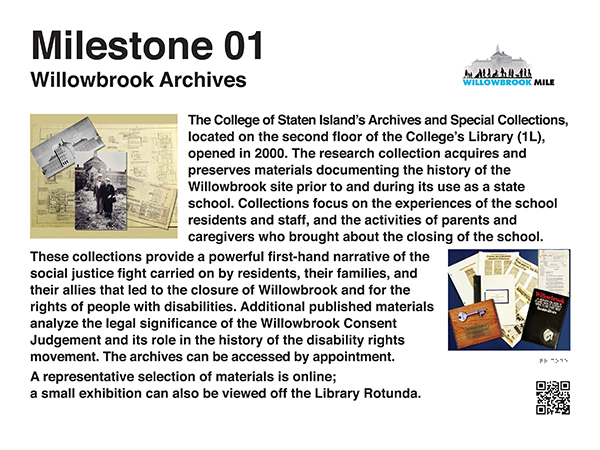
Milestone 02 - Building 19
In the mid-1990s, the College of Staten Island installed a plaque on its 3S Building to honor its identity as “Building 19" of Willowbrook State School. This massive institution on over 380 acres required a system of steam tunnels that connected the buildings to a central plant providing heat and electricity. The mere scope and size of the facility impaired its ability to provide normal, personalized comfort and care. Willowbrook soon became overcrowded. Its buildings failed to provide residents with adequate space, resulting in a loss of personal dignity and privacy. The facilities became filthy, disease-ridden, inhumane warehouses. Nearly 200 men lived in this building originally designed to house fewer than 100. This plaque honors each and every person who resided at Willowbrook. The painted Number "19" is preserved in respectful remembrance.
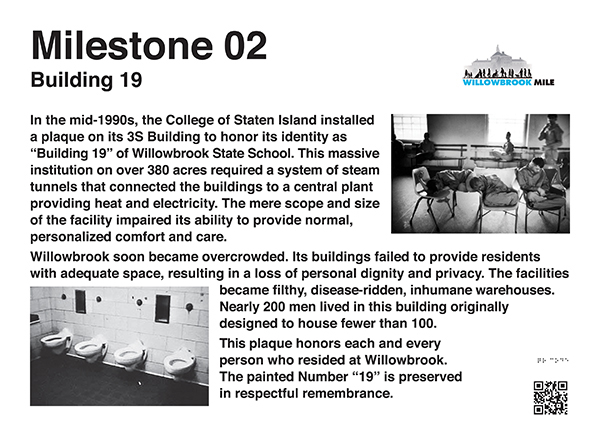
Milestone 03 - Halloran Hospital
In 1938, New York State authorized the building of a school for "mental defectives." The Willowbrook site was selected and buildings erected. When the U.S. entered World War II in the 1940s, New York State turned over the site to the U.S. Army for use as a hospital and prisoner of war camp. Halloran General Hospital soon became the largest Army hospital in the U.S. It was known for orthopedic and reconstructive surgery and a humanistic standard of care. At its peak, it treated over 2,500 soldiers daily. At the war's end, Halloran became a veterans' hospital. In 1951, Halloran closed and the Army returned the property to NY State for its intended purpose as the Willowbrook State School.
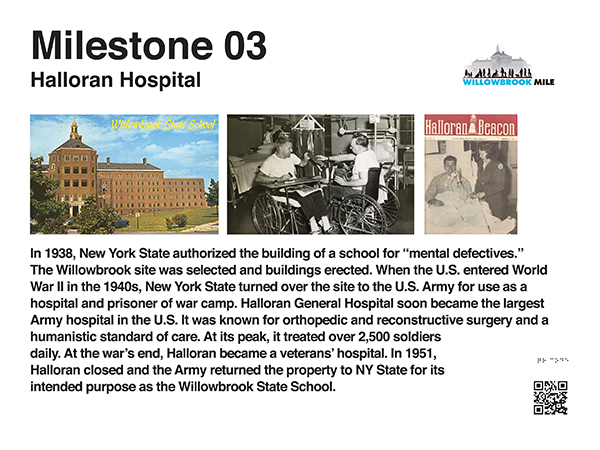
Milestone 04 - Consent Judgement
The 1975 Consent Judgement ordered that Willowbrook residents must receive adequate clinical and educational services. This set in motion the eventual closure of Willowbrook in 1987 and began the development of community-based services. It mandated a reduction from 6,000 to 250 residents by 1981. The Consent Judgement was revolutionary. It can be linked to the placement of persons with developmental disabilities in community residences, the growth of voluntary agencies, the expansion of special education and day programs, and the training of direct-care workers, therapists, teachers, and administrators. Along with the 1975 Education for All Handicapped Children Act, the Consent Judgement helped lead to later key legal protections, including the 1990 Americans with Disabilities Act (ADA).
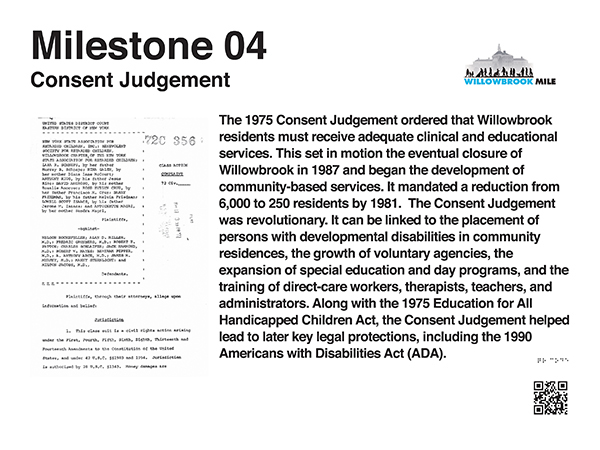
Milestone 05 - Isolation to Inclusion
In 1993, the College of Staten Island/CUNY (CSI) moved onto 204 acres of the former Willowbrook State School site. A comprehensive college in The City University system, CSI offers programs from pre-college through the doctoral level, including training professionals in the fields that address the needs of persons with disabilities. In recognition of the Willowbrook legacy, it also has programs that serve students of differing abilities, including the Melissa Riggio Higher Education program, which offers college experience to persons with varying disabilities. CSI's presence and mission demonstrate the powerful transformation of educational opportunity at the Willowbrook site from institutionalization and isolation to integration into society. Having emerged from a painful period of stifled growth, this site now continually strives to offer hope and opportunities for an enriched life for all.
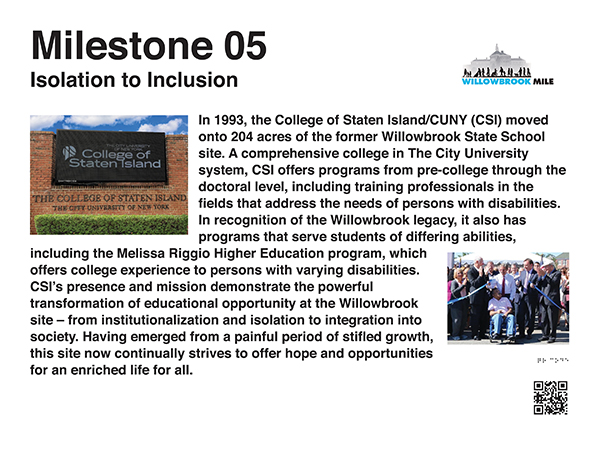
Milestone 06 - Exposing Conditions at Willowbrook
Willowbrook State School, the largest facility in the world for people diagnosed with "mental retardation," had been criticized for years. In 1965, Senator Robert F. Kennedy visited and called for an investigation, but no action was taken. In 1971, Staten Island Advance reporter Jane Kurtin published a series of powerful articles revealing the appalling conditions, but no changes resulted. Two Willowbrook physicians -- William Bronston and Michael Wilkins -- had been meeting with families and staff to mobilize advocates to address the severe problems caused by understaffing and overcrowding. They brought ABC journalist Geraldo Rivera onto the grounds in the middle of the night to film the horrendous conditions. Rivera's 1972 exposé remains the most explosive and realistic television investigation of the cold, stark, inhuman nature of institutionalization. The exposé set the foundation for the Consent Judgement of 1975, establishing that Willowbrook residents had a Constitutional right to be protected from harm a clear cornerstone in the civil rights movement for people with disabilities.
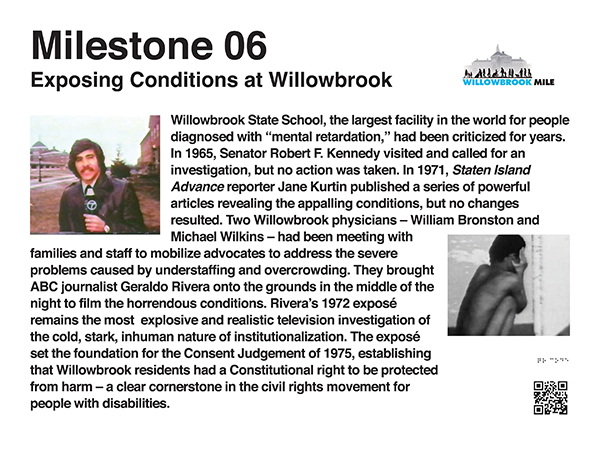
Milestone 07 - Baby Unit
We know today how important nurturing and stimulation in the first years of children's lives are to their development. But in the 1960s, when the Baby Unit complex was built, the medical community routinely recommended institutionalization for children whose development appeared to be delayed. With no other resources available, many families agonized over the decision to place their child at Willowbrook but they did so with the belief that their child would receive special care and training there. Sadly, within the institutional system, staff struggled even to meet the children's basic needs for personal care, active treatment, and protection from harm. Class-action litigation, won by families and advocates in 1975, made community services available that gave families the opportunity to care for their children at home. This Ied to the creation of a specific agency to support those with developmental disabilities. Today the Office for People with Developmental Disabilities manages a statewide service system to address these needs.
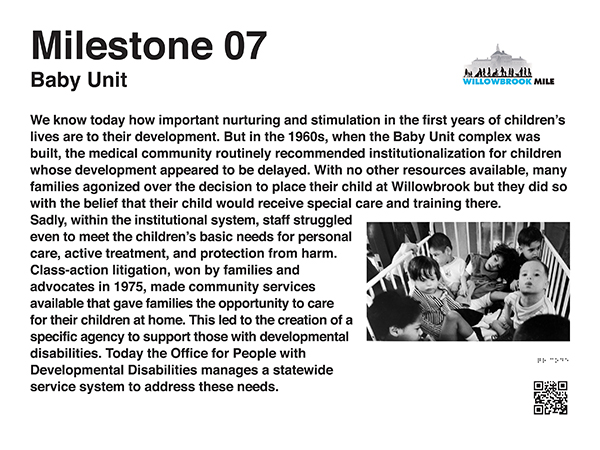
Milestone 08 - Connelly Center
As the first woman from Staten Island elected to public office, Elizabeth Connelly served as Assemblywoman from 1973 to 2000. Connelly was a key advocate for the rights of people with developmental disabilities and the force behind the creation of a separate state agency to meet their needs. Following her example, the Staten Island Developmental Disabilities Council, founded in 1969, continues her sustained advocacy and constant vigilance to ensure that persons with disabilities receive the opportunities needed to lead lives of value and worth. In 1990 the Elizabeth Connelly Resource Center was named to commemorate her outstanding advocacy and leadership; it houses a number of programs and organizations that support this community.
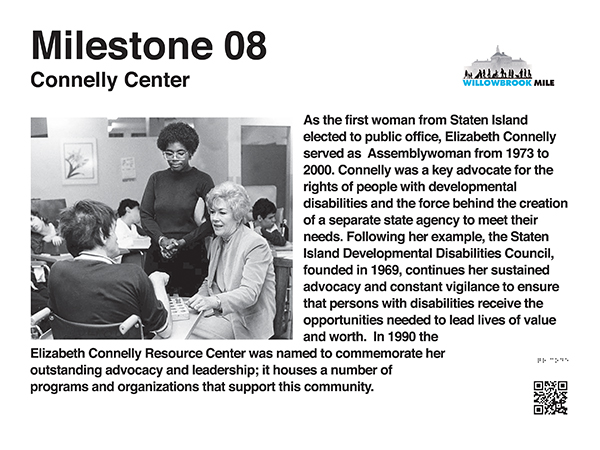
Milestone 9 - Building 29
Building 29 remains as it was in the 1980s as part of the Willowbrook State School. In its original state, it reflects the extremely difficult conditions in which residents lived. It had originally housed individuals with significant disabilities. In the era that followed the 1975 Consent Judgement, Building 29 became the home for residents whose families were from Staten Island. The housing of persons based on geography rather than their needs made providing adequate and appropriate care more challenging. Limited improvements were made to the physical environments in which they lived. Dividers and curtains gave them some privacy where there had been none. By the closure in 1987, these individuals left Building 29 to enter community life.
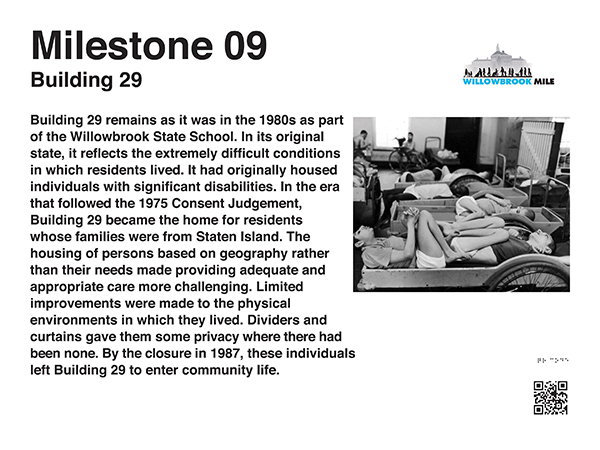
Milestone 10 - Institute for Basic Research
New York State's Institute for Basic Research in Developmental Disabilities (IBR) opened in 1968 as the first large-scale institute in the world to conduct basic and clinical research into the causes of developmental disabilities. IBR develops methods of prevention, diagnosis and treatment of such conditions, and provides biological, laboratory, and psychological services. It also educates professionals and the public regarding the causes, diagnosis, prevention, and treatment of developmental disabilities. IBR has made significant research and treatment contributions in the areas of Autism Spectrum Disorders, Fragile X and Down syndromes, phenylketonuria (PKU), the role of taurine in human development, the treatment of Batten Disease, and other areas. IBR operates the George A. Jervis Diagnostic and Research Clinic, providing high-quality diagnostic and treatment services. IBR also provides educational and mentoring opportunities to graduate students, some of whom come from the College of Staten Island/IBR Center for Developmental Neuroscience and Developmental Disabilities, a joint CSI/IBR venture.
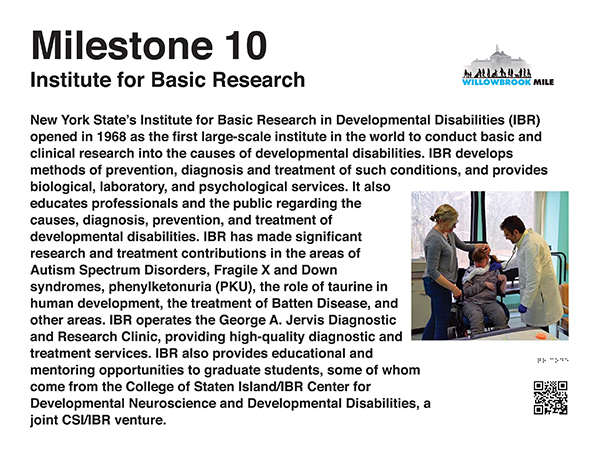
Milestone 11 - Hepatitis Study
In the Willowbrook Hepatitis Study (1956-1971), NYU medical researchers intentionally infected about 700 residents ages five to ten with hepatitis to study the viral disease. They justified this with claims that hepatitis infections were already high among residents, and children would be infected anyway. But critics decried the ethics of the research. Researchers coerced parents' consent with promises of better care for participants and by not revealing their exposure to danger without benefit. Therefore, parents' consent was not given freely and was not "informed consent." Further, test subjects faced unacceptable risks: a number became life-long carriers of hepatitis, suffering long-term or permanent health effects, including liver damage and shortened lives.
The Hepatitis Study, along with the infamous Tuskegee Syphilis Study, is now condemned as a key example of unethical human experimentation on vulnerable test subjects-children, prison inmates, mental patients, the underprivileged, and communities of color. In 1974, inspired by Willowbrook and Tuskegee, Congress passed the National Research Act, with federal regulations to protect human research subjects.
Milestone 12 - Gouverneur State School
In 1962, to address Willowbrook overcrowding, the New York State Department of Mental Hygiene began quietly transferring about 200 children and infants with severe disabilities to the condemned former Gouverneur Hospital in Manhattan's lower East Side. The majority of transferred children did not speak or walk and the State claimed that they had a short life expectancy. Officials justified the use of a condemned site because the placement would be short-term, but in fact the State ignored the human needs of the children being transferred.
The Gouverneur transfers are central to the Willowbrook story, illustrating the lack of available care and the fight for residents' and parents' rights. In advocating for their children, the Gouverneur Parents' Association built partnerships among families, staff, journalists, and the community (including Black Panthers and Young Lords). In essence, the legal struggle that led to Willowbrook's eventual closure began at Gouverneur. In 1971, the Gouverneur parents successfully won a court injunction ordering New York State to establish care for their children that respected their essential human rights. (Photographs by Nancy Starrels)
